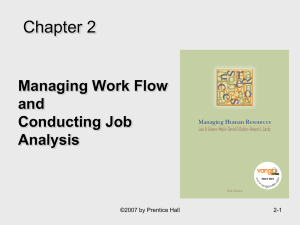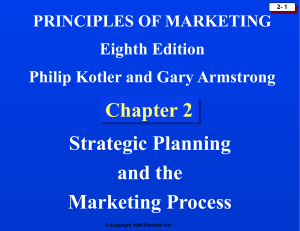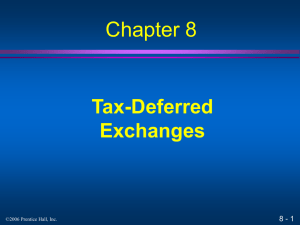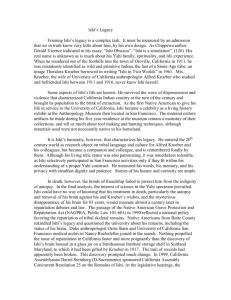competencies.
advertisement
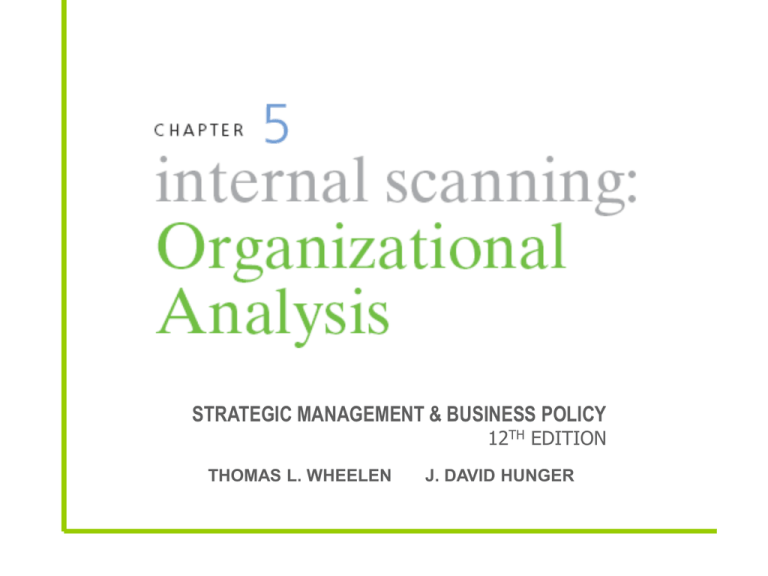
STRATEGIC MANAGEMENT & BUSINESS POLICY 12TH EDITION THOMAS L. WHEELEN J. DAVID HUNGER Prentice Hall, Inc. ©2009 1-2 Organizational analysis- concerned with identifying and developing an organization’s resources and competencies. Prentice Hall, Inc. ©2009 5-3 Core and Distinctive Competencies Resources An organization assets – tangible and intangible assets. Capabilities A corporation’s ability of various function to exploit its resources. Competency A cross-functional integration and coordination of capabilities. Core competency A collection of competencies that cross divisional boundaries. Distinctive competency Core competencies superior to those of the competitors. 5-4 Prentice Hall, Inc. © 2006 ISHI TON Core and Distinctive Competencies VRIO framework (Barney) IPAD Value Does it provide customer value and competitive advantage? Rareness Do no other competitors possess it? Imitability Is it costly for others to imitate? Organization Is the firms organized to exploit the resource? 5-5 Prentice Hall, Inc. © 2006 Imitability an Advantage Durability- the rate at which a firm’s underlying resources, capabilities, or core competencies depreciate or become obsolete. Imitability- the rate at which a firm’s underlying resources, capabilities, or core competencies can be duplicated by others. ISHI TON Prentice Hall, Inc. ©2009 IPAD 5-6 Determining the Sustainability of an Advantage Transparency- the speed at which other firms understand the relationship of resources and capabilities supporting a successful firm’s strategy. Transferability- the ability of competitors to gather the resources and capabilities necessary to support a competitive challenge. Replicability- the ability of competitors to use duplicated resources and capabilities to imitate the other firm’s success. ISHI TON Prentice Hall, Inc. ©2009 IPAD 5-7 Determining the Sustainability of an Advantage Explicit knowledge- knowledge that can be easily articulated and communicated. Tacit knowledge- knowledge that is not easily communicated because it is deeply rooted in employee experience or in the company’s culture. ISHI TON Prentice Hall, Inc. ©2009 IPAD 5-8 Prentice Hall, Inc. ©2009 5-9 Business models- a company’s method for making money in the current business environment. • • • • • Includes Who the company serves What the company provides How the company makes money How the company differentiates and sustains competitive advantage How the company provides its product/service Prentice Hall, Inc. ©2009 5-10 Business models • • • • • Customer solutions model-IBM/SAP/Oracle Profit pyramid model-GM/Toyota Multi-component system/installed model-Gillette Advertising model-Hotmail/Yahoo Switchboard model-Bank/Card/Finance/Insurance Prentice Hall, Inc. ©2009 5-11 Value chain- a linked set of value creating activities that begin with basic raw materials coming from suppliers, moving on to a series of value-added activities involved in producing and marking a product or service, and ending with distributors getting the final goods into the hands of the ultimate consumer Prentice Hall, Inc. ©2009 5-13 Basic Organizational Structures • • • • • Simple-small firm, one or two product lines, no functional or product categories. Functional -medium firm, several product lines in one industry, with functions. Divisional-large corporation, several product lines in several related industries, with functions under separate divisions. Strategic Business Units (SBU)-independent division or groups of divisions. Conglomerate (Holding Company)-large corporation, many product lines in several unrelated industries, many legally independent firms. Prentice Hall, Inc. ©2009 5-14 Prentice Hall, Inc. ©2009 5-15 Corporate Culture: The Company Way Corporate culture- the collection of beliefs, expectations and values learned and shared by a corporation’s members and transmitted from one generation of employees to another. – HP-R&D – Maytag-product quality – Kasikorn Bank-customer satisfaction – Siam Commercial Bank-integrity, accountability and teamwork. – Siam Cement Group-corporate governance Prentice Hall, Inc. ©2009 5-16 Corporate Culture: The Company Way Cultural intensity- the degree (depth) of which members of a unit accept the norms, values and other cultural content associated with the unit. Shows the depth of the culture. Cultural integration- the extent (breadth) of which units throughout the organization share a common culture. Shows the breadth of the culture. Prentice Hall, Inc. ©2009 5-17 Strategic Marketing Issues Market position- Who are our customers? Marketing Mix- the particular combination of key variables under a corporation’s control that can be used to affect demand and to gain competitive advantage Prentice Hall, Inc. ©2009 5-18 Prentice Hall, Inc. ©2009 5-19 Product life cycle- product monetary sales over time from introduction through growth and maturity to decline Prentice Hall, Inc. ©2009 5-20 Brand- a name given to a company’s product which identifies that item in the mind of the consumer. Corporate brand- a type of brand in which the company’s name serves as the brand. Prentice Hall, Inc. ©2009 5-21 Corporate reputation- a widely held perception of a company by the general public. • • Stakeholders’ perceptions of quality Corporation’s prominence in the minds of stakeholders Prentice Hall, Inc. ©2009 5-22 - IFAS Must assign running numbers Total weight must add up to 1 To SFAS table To SFAS table The most important internal factors are identified in the IFAS table as shown here by shading these factors. Prentice Hall, Inc. ©2009 5-30





